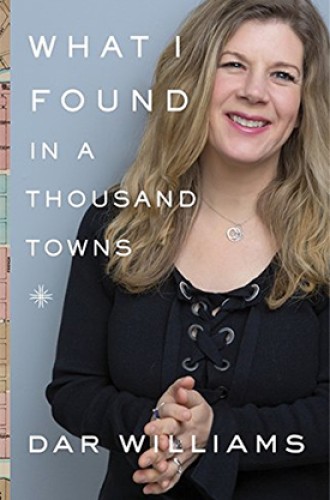Dar Williams has hope for America's small towns
The folk singer has observed what brings neighbors together in communities where she performs.
One part urban planning, two parts community organizing, this text is a testament of hope amid the decline and despair of many American small towns. Drawing upon her experience as a traveling folksinger, Dar Williams highlights the struggles and successes of eight communities—from Moab, Utah, to Middletown, Connecticut, to the Finger Lakes region of New York, to Gainesville, Florida—and offers an account of how potentially demoralized towns can remain vital despite crushing economic blows.
Positive proximity is the term Williams coins to describe an organic approach to community development. It’s “a state of being where living side by side with other people is experienced as beneficial.” The goodwill garnered by positive proximity is a currency that can be used to broker a collective vision. Positive proximity is accomplished when residents pay attention not only to local spaces and projects but also to what Williams calls translation—“all the acts of communication that open up a town to itself and to the world.”
Translation requires “a tacit commitment to facilitating all the variegated voices and personalities in our towns.” In every town, there are folks who have their finger on the pulse of the community. They know who is doing what, where, why, and when, and how it all turned out. Williams dubs these astute leaders “conscious bridgers.” They “weave together disparate fibers of a town’s identity, open channels of communication, and turn up the volume on all that is fun and good in a town, often initiating those fun and good things on their own.” In so doing, they translate the work of their town to people within and beyond its borders.
Williams is an engaging performer, and her music is passionately playful, touching on deep and sometimes neglected truths. Her prose is similarly beautiful, lyrical, and carefully crafted. Referring to the physical components of a place and its role within a dynamic community, she writes, “Maybe the land itself can be the calmer of disputes. The land holds time differently than we do.”
Williams’s lyrics often speak directly to the sociological work she is doing. “With new ideas come new conversations,” she writes, citing the lyrics of one of her songs: “The Christians and the Pagans sat together at the table / Finding faith and common ground the best that they were able / And just before the meal was served, hands were held, and prayers were said / Sending hope for Peace on Earth to all their gods and goddesses.”
I hoped these songs, like dispatches from the frontiers of a new social landscape, might allow audiences to recognize themselves as part of a new American narrative in which the paradigm of a stern, rigid pater- or materfamilias presiding over a table of silent relatives was giving way to grandchildren who dared to keep in their nose rings and even show up with a same-sex partner. . . . I have been told, every day I’ve ever been on tour, that my friends’ songs and concerts—and yes, my own as well—have been ice breakers for families and communities.
Ideas evolve and minds change slowly. With patience and a supposition of good will, Williams believes, a shift can occur as space is created to reenvision and open up our landscape.
Williams occasionally mentions the role that faith communities can play in fostering positive proximity. Beacon, New York, for example, collectively celebrates the Jewish harvest festival of Sukkot by erecting a traditional sukkah in a public park. It becomes the venue for an array of classes, discussions, and workshops. This practice has laid a foundation for fruitful interfaith dialogue and action.
Faith communities are, Williams says, uniquely situated to encourage positive proximity:
Faith groups can argue that with the role conscience plays in all houses of worship, they can address issues of disenfranchisement, illness, disability, and economic hardships especially, and sometimes exclusively, very effectively within their own communities. There is a store of social capital they can build to very secure levels.
Such social capital is every bit as important as financial capital when it comes to revitalization efforts.
Nevertheless, one cannot overlook the necessity of financial funding. Williams defines what she calls “a piñata problem” in her discussion of Wilmington, Delaware: “There is great wealth, but it’s hanging from a high place, far away from the city commons.” Despite this admission, Williams fails to offer any concentrated treatment of the economic disparities at work in small towns.
The book’s abrupt ending is also a lost opportunity. I found myself wishing for something tangible: the inclusion of a succinct outline for action, a bibliography, or a compilation of resources to encourage aspiring conscious bridgers.
Perhaps the book’s greatest strength is to help readers locate the vitality of their own towns. Within that vitality there may yet be a hopeful way forward, “one coffee shop, dog run, and open-mike night at a time.”






